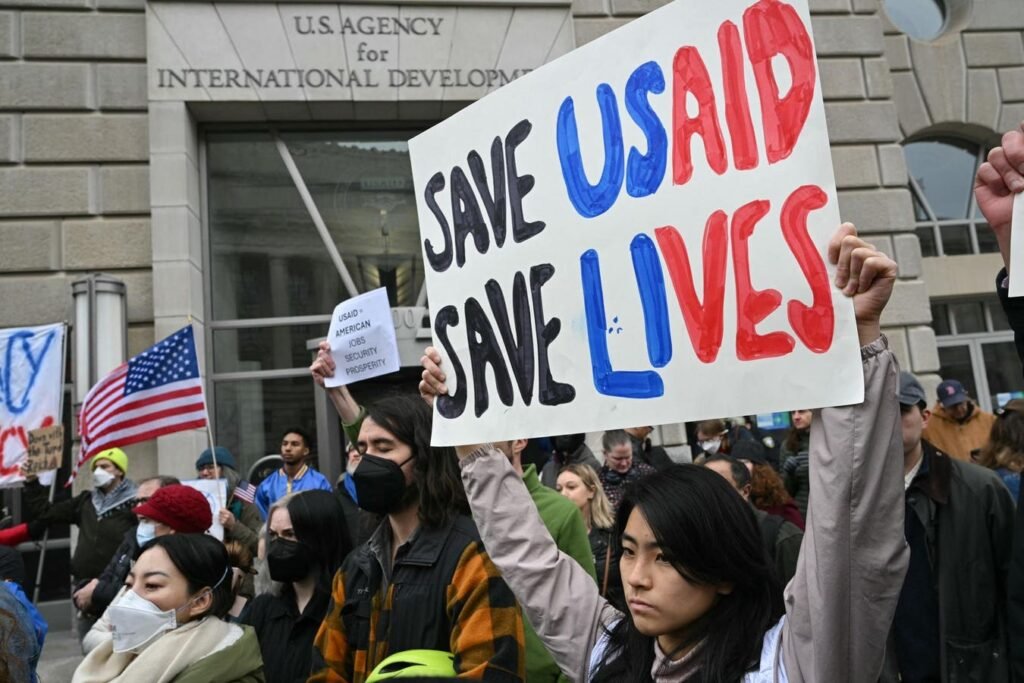People protest outside of the headquarters for United States Agency for International Development. (Photo by Mandel NGAN / AFP) (Photo by MANDEL NGAN/AFP via Getty Images)
AFP via Getty Images
A Lancet paper published in July evaluates data to illustrate the importance of roughly two decades of American humanitarian aid offered through the United States Agency for International Development and the President’s Emergency Plan for AIDS Relief. The piece subsequently projects what the future could look like in light of the steep cuts imposed by President Trump to USAID and PEPFAR.
Authors estimate that USAID-funded programs have helped prevent more than 91 million deaths globally in the past 20 years, including 30 million fatalities among children. Projections suggest that ongoing deep funding cuts—combined with the dismantling of the agency—could result in more than 14 million additional deaths by 2030.
On inauguration day, President Trump ordered a sweeping 90-day spending freeze on virtually all U.S. foreign aid, including many forms of health and food assistance. An independent agency, USAID, was largely gutted.
The USAID undertakes a wide range of activities, which include among other things food aid and distribution (often in conflict zones), clean water provision, maternal and infant health support, mass administration of rehydration salts for children suffering from diarrhea, malaria prevention and treatments and polio vaccinations in countries where the disease is still endemic.
The agency was established under President John F. Kennedy in the early 1960s to administer humanitarian aid programs around the world. Congress appropriates funds for USAID’s operations. The agency employed roughly 10,000 people, two-thirds of whom worked overseas. In fiscal year 2024, the agency received more than $44 billion in federal funding. Most of that money was spent in Asia, sub-Saharan Africa and Europe (primarily on humanitarian efforts in Ukraine). While a considerable sum, it merely accounts for 0.4% of the entire federal budget.
The Trump administration has slashed 86% of USAID funding. Only a small fraction of aid programs remains in place. The employee head count is now under 500.
As carried out by successive administrations since Bush, including the first Trump administration, PEPFAR represented the largest commitment in history by any nation to address a single disease, HIV/AIDS. But gradually the second Trump administration is unraveling this initiative, too. KFF reported that while PEPFAR received a limited waiver on Feb. 1, allowing it to continue certain “life-saving HIV services,” the waiver doesn’t include essential pre-exposure prophylaxis for anyone other than pregnant and breastfeeding women. The State Department has sought $2.9 billion in funding to continue HIV-AIDS programs in the next fiscal year—considerably lower than PEPFAR’s current budget of $4.1 billion. Moreover, USAID was the main agency working on behalf of PEPFAR. Without USAID and its staff, PEPFAR’s implementation capacity has been seriously affected.
Going forward, the Trump administration intends to transform PEPFAR from an aid program to one that is aligned with its “America First” priorities. The plan, as described by the New York Times, outlines the administration’s intentions to “transition” countries off of PEPFAR, in some cases within two years. The program would in essence no longer be involved in aid and saving lives overseas. Rather, it would focus on detecting outbreaks that could threaten the U.S. and at the same time create new markets for American drugs and technologies.
On the ground, journalists are painting a grim picture of the implications of the drastic curtailment in U.S. aid. A story in America Magazine, for example, describes in detail the local impact in Eswatini, a country in Southern Africa, of the gutting of USAID and reductions in PEPFAR. Cuts have severely limited access to HIV treatments and testing in clinics.
During the height of the HIV/AIDS pandemic, the population of Eswatini plummeted, and life expectancy dropped from 61 in 1988 to 44 by 2003. It reverted to 61 in 2023, thanks in large part to USAID and PEPFAR. But now the gains in health outcomes are in jeopardy.
The ramifications of a greatly diminished U.S. presence in health aid, international development and disaster assistance could be profound, specifically around the global humanitarian programs which rely on USAID. In terms of international assistance, the U.S. was by far the world’s largest donor. The U.S. spent $68 billion on international aid in 2023.
And the Trump administration’s actions are also affecting what is termed the President’s Malaria Initiative, an organization also founded by former President Bush. Through the work of this entity, the U.S. had become the global leader in donating to anti-malaria programs and research. According to the New York Times, one of Trump’s executive orders has led to two-thirds of the staff being let go from the Malaria Initiative.
And by pulling out of the World Health Organization, Trump further diminishes the critical role the U.S. plays in combating neglected tropical diseases, such as leishmaniasis, river blindness, Dengue fever and trachoma. These preventable and mostly treatable infectious diseases affect millions of people in tropical regions of the world, causing severe health problems, including anemia, blindness, chronic pain, infertility and bodily disfigurement. Historically, despite the large burden imposed by neglected tropical diseases on many people, they’ve received a relatively small portion of resources for drug development and treatment distribution. U.S. aid agencies had been filling some of the void. Until now.


